4
Architecture, Urban Design, and Sustainable Cities in China and the United States
The second panel of the workshop focused on urban design and landscape architecture as critical components for urban sustainability. The use of nature-based solutions; microclimate regulation for connecting science, policy, and design; and efforts to maximize human well-being through urban design in both countries were discussed. Robert Cervero, professor emeritus of city and regional planning at University of California, Berkeley, moderated the session. He began by noting there are key questions around how to design built and natural environments in urban areas; the science-policy interface is critical; and it is important to consider who should be taking the lead to implement solutions.
NATURE-BASED SOLUTIONS AND PERFORMANCE
According to Kongjian Yu, professor of urban and regional planning and landscape architecture at Peking University, nature-based solutions will be critical to addressing urban sustainability challenges (see Box 4-1). Most cities in China are facing multiple environmental and ecological challenges including floods and urban inundation, drought, groundwater reductions, water pollution, habitat loss, and air pollution, and single-goal minded, industrial technology-based gray infrastructure is not sufficient to solve these interconnected problems. Dr. Yu noted that looking to ancient wisdom as a source of nature-based and holistic solutions can inform decisions about how to address urban challenges and secure ecosystems services.
Over a period of 20 years, Dr. Yu reported having tested and built over 500 projects in 200 cities in China that have integrated nature-based solutions to address key urban challenges at various scales. For example, Dr. Yu described work at Yongning River Park in Zhejiang in 2003, which demonstrated an ecological approach to flood control and stormwater management while offering space for public enjoyment (Figure 4-1).
Dr. Yu described another example in Yanweizhou Park in Jinhua City, Zhejiang Province, using natural mechanisms to clean contaminated water that introduced an ecological embankment to reduce peak flow. This initiative, if implemented comprehensively throughout the drainage, can result in reducing the flow by more than half at the basin’s outlet, making the city more water resilient. As a solution for water management challenges,
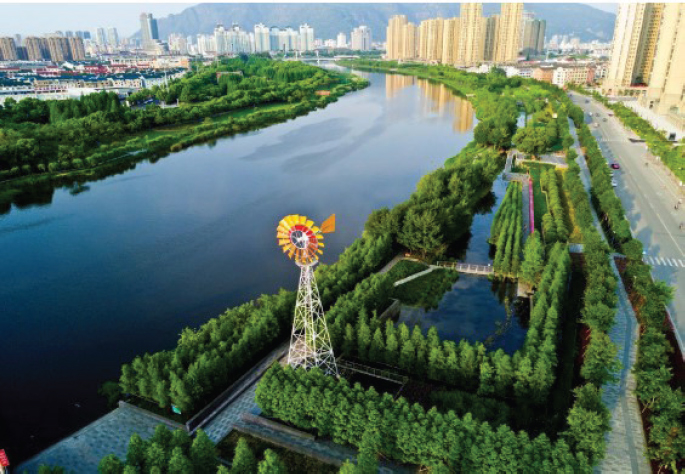
SOURCE: Kongjian Yu, Presentation, National Academies of Sciences, Engineering, and Medicine, December 16, 2019, Washington, DC.
Dr. Yu described a demonstration project of a “sponge city”1 in Sanya, Hainan Province, that addresses urban inundations and floods through a constructed wetland inspired by the ancient wisdom of pond-dyke practice in the middle of the city. The project was designed to retain and filtrate stormwater, which solved multiple urban water issues in a symbiotic way.
In another project for Houtan Park in Shanghai, Dr. Yu demonstrated a strengthened nature-based water cleansing process that can clean contaminated river water to nonpotable clean water through a constructed wetland park, suggesting one hectare of this kind of wetland can produce 800 tons of nonpotable water. This nature-based water cleansing design has been replicated in many cities in China, such as Haikou’s Meishe River (Figure 4-2).
Dr. Yu added that today more than ever, a paradigm shift in the planning and design of cities is needed to adapt to the changing climate
__________________
1 For additional information related to the sponge city concept, see Yu, K. 2017. Green infrastructure through the revival of ancient wisdom. Bulletin of the American Academy of Arts & Sciences:35–39.
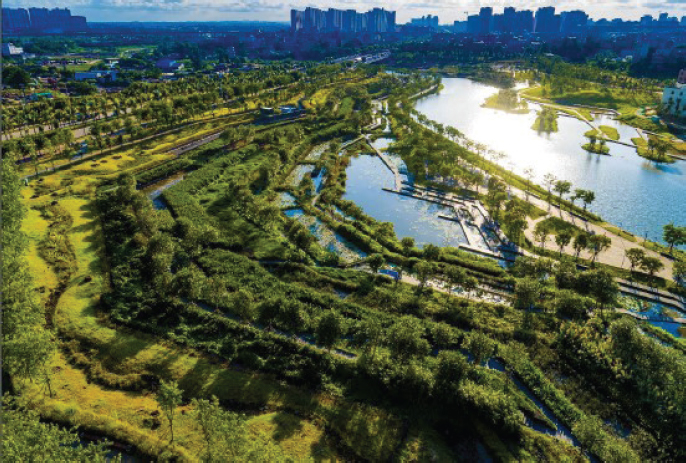
SOURCE: Kongjian Yu, Presentation, National Academies of Sciences, Engineering, and Medicine, December 16, 2019, Washington, DC.
and to address a multitude of urban ecological issues. Such a shift calls for rethinking the way cities are built, moving toward nature-based solutions.
Moving forward, Dr. Yu posed the following questions for informing future research on nature-based solutions to urban sustainability challenges:
- How can we change our mindset (and policy) to move toward nature-based systems?
- How can we fully assess the performance of nature-based solutions?
- How can we standardize nature-based solutions for climate change adaptation and ecological restoration and scale them to meet larger economic and policy needs?
MICROCLIMATE REGULATION IN CITIES
V. Kelly Turner, assistant professor of urban planning at University of California, Los Angeles, focused her presentation on key challenges and potential pathways for developing actionable science to address the problem of rising temperatures in cities. She discussed the disjuncture between
regional scale/generalizable science and the practical everyday decisions that municipalities must make to deal with urban heat issues. There are several key barriers to actionable climate science, including incomplete knowledge around urban design and microclimate (see Figure 4-3). Without addressing some of these barriers, responses to these critical issues will continue to be limited, said Dr. Turner.
Other barriers include limitations around climate data (most available data are coarse) and urban heat profiles. Dr. Turner also pointed to a lack of good understanding of how people use space, as well as a general lack of systemic monitoring of urban sustainability interventions. A disconnect between generalizable, regional urban climate science models and the hyperlocal and context-dependent nature of urban design interventions can lead to policy “panaceas,” which she defined as a mismatch between environmental benefit narratives and actual performance in situ.
However, urban environments are replete with naturally occurring experiments that can inform research and action on urban issues. Reframing urban design as urban experiments, akin to the role of environmental policy in the adaptive management process, is a productive first step in reconnecting science and design, stated Dr. Turner.
Dr. Turner added that novel approaches, such as microclimate zones with land cover types at tens of meters, may be used as a tool to guide design at the hyperlocal scale. This level of analysis can allow a focus on a limited suite of controlled conditions that determine, for example, the heat outcomes at those scales. While Stewart and Okie’s (2012)2 local climate zones for urban temperature studies provide a typology of urban land cover types at hundreds to thousands of meters, microclimate zones also allow for a move toward a user-centered approach by effectively summarizing field data at scales that are relevant to municipalities.
Dr. Turner also described the importance of maximizing cobenefits in urban design, highlighting the example of an art installation that used solar paint (see Figure 4-4). It has the cobenefit of reducing heat produced in the built environment as well as beautifying the space. The arts can provide creative solutions to urban challenges, said Dr. Turner.
__________________
2 Stewart, I. D., and T. R. Oke. 2012. Local climate zones for urban temperature studies. Bulletin of the American Meteorological Society, 93:1879–1900. http://dx.doi.org/10.1175/BAMS-D-11-00019.1.
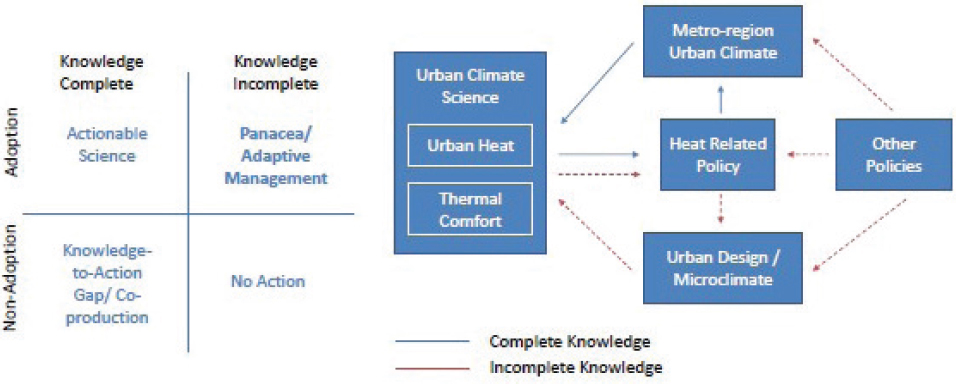
SOURCE: V. Kelly Turner, Presentation, National Academies of Sciences, Engineering, and Medicine, December 16, 2019, Washington, DC.
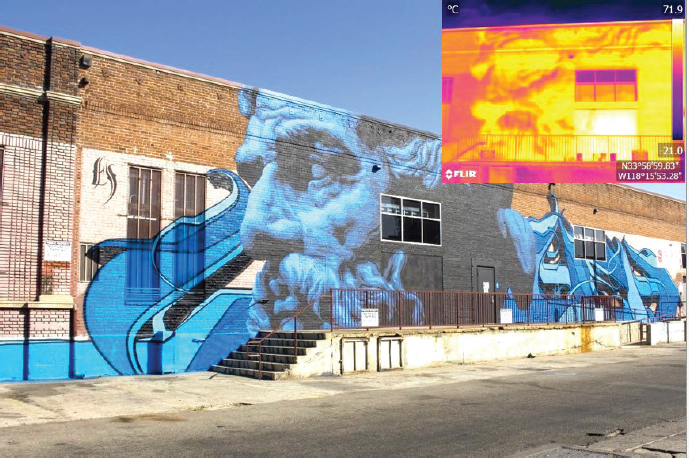
SOURCE: V. Kelly Turner, Presentation, National Academies of Sciences, Engineering, and Medicine, December 16, 2019, Washington, DC. Thermal imagery created by Ariane Middel, Arizona State University, and photography by Mary Braswell, University of California, Los Angeles.
HAPPY CITIES:
MAXIMIZING HUMAN WELL-BEING THROUGH URBAN DESIGN
Yingling Fan, professor in the regional planning and policy area at University of Minnesota, provided additional insight into how urban design can impact human well-being by discussing her research on transportation and happiness in China and the United States,3 particularly how design can impact or affect emotions. Dr. Fan said that an understanding about how public spaces can evoke emotions can inform future urban design decisions.
Transportation is an emotional landscape, said Dr. Fan. In any U.S. urban area, significant portions of land are devoted to streets, parking, public transit, and sidewalks. Dr. Fan described efforts to study human
__________________
3 Fan, Y., R. Brown, K. Das, and J. Wolfson. 2019. Understanding trip happiness using smartphone-based data: The effects of trip- and person-level characteristics. Transport Findings. https://doi.org/10.32866/7124. Accessed March 9, 2020.
happiness and travel using an app to measure human behavior. The researchers observed differences between levels of happiness and/or stress based on the modes of travel in Shenzhen and Minneapolis (see Figures 4-5 and 4-6). For example, biking and walking seem to make people happier than using cars in Minneapolis (see green bars), while those greener modes seem to make people less happy than using cars in Shenzhen. There is a need to create a transportation structure that makes people happier when they take greener modes, Dr. Fan stated.
This research examined how various modes of travel and their impact on well-being could be used to inform policy decisions. Dr. Fan also described efforts to examine happiness as it correlates with other factors, for example, having a travel companion, distance and duration, gender, and age, among others. Through this type of work, researchers are able to examine which streets in urban areas are considered risky and which make people happy. Dr. Fan concluded by stating that urban design strategies that focus on cobenefits toward both environmental sustainability and human well-being will have more long-lasting and broader population-level impacts than strategies that merely focus on environmental sustainability.
A CLIMATIC PERSPECTIVE
Matei Georgescu, associate professor in the School of Geographical Sciences and Urban Planning in the College of Liberal Arts and Sciences at Arizona State University, further discussed urban design and architecture, focusing on heat and climate issues. Dr. Georgescu noted that there are twin forcing agents driving climate change in urban environments: greenhouse gasses (GHGs) and the physical built environment. If cities are focused solely on reducing GHG emissions, they are missing half of the problem.
In the urban climate system, there is a balance of incoming and outgoing energy fluxes. Surface energy budgets of urban areas and their more rural surroundings differ because of variability in (1) land cover and surface characteristics, and (2) level of human activity (e.g., how people use energy). Dr. Georgescu described analyses of individual versus total impacts of GHGs4 and urbanization, including adaptation scenarios, such as the
__________________
4 Georgescu, M., P. E. Morefield, B. G. Bierwagen, and C. P. Weaver. 2014. Urban adaptation can roll back warming of emerging megapolitan regions. Proceedings of the National Academy of Sciences of the United States of America 111(8):2909–2914.
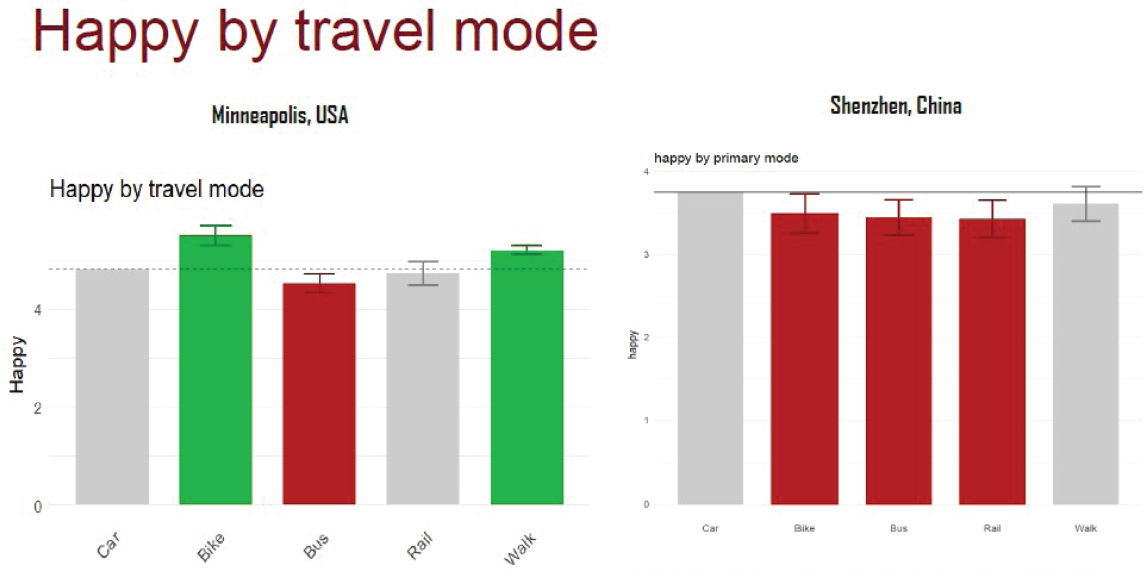
NOTE: Adjusted for age, sex, race, employment status, income, family status, general health, life satisfaction, optimism/pessimism, disability, neighborhood characteristics, and trip duration.
SOURCE: Yingling Fan, Presentation, National Academies of Sciences, Engineering, and Medicine, December 16, 2019, Washington, DC.

NOTE: Adjusted for age, sex, race, employment status, income, family status, general health, life satisfaction, optimism/pessimism, disability, neighborhood characteristics, and trip duration.
SOURCE: Yingling Fan, Presentation, National Academies of Sciences, Engineering, and Medicine, December 16, 2019, Washington, DC.
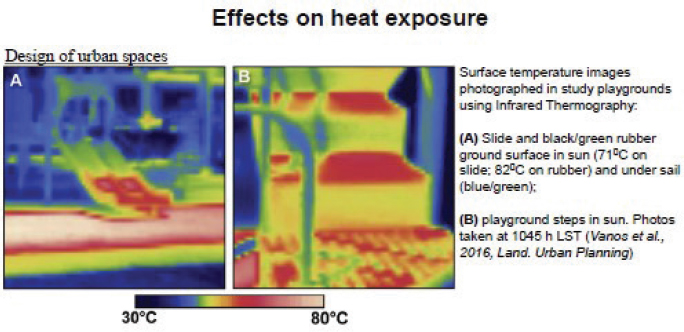
SOURCE: Matei Georgescu, Presentation, National Academies of Sciences, Engineering, and Medicine, December 16, 2019, Washington, DC. Reprinted from Vanos, J. K., A. Middel, G. R. McKercher, E. R. Kuras, and B. L. Rudell. 2016. Hot playgrounds and children’s health: A multiscale analysis of surface temperatures in Arizona, USA. Landscape and Urban Planning 146:29–42, with permission from Elsevier.
dynamic interaction between effects of climate change and urban expansion from the continental U.S. perspective.5
Dr. Georgescu noted that heat waves are occurring more frequently and the resulting effects of heat exposure on human health are being seen. Using an example of the impact of heat on urban design in Phoenix, Arizona, Dr. Georgescu noted that the surface temperature images of playgrounds show the potential for health impacts of a heat wave on children in a community (see Figure 4-7).6 Indoor living environments during these heat waves are also of concern in the United States and, especially, elsewhere.
Dr. Georgescu discussed key knowledge gaps around sustainable urban settlements, including the need for scaling from local to regional levels as well as for the impact of research activities into the desired outcomes framework. The scientific community currently does not know what the desired outcomes are or should be, in large part because they are place-based and differ from one geographical location to another.
__________________
5 See Krayenhoff, E. S., M. Moustaoui, A. M. Broadbent, V. Gupta, and M. Georgescu. 2018. Diurnal interaction between urban expansion, climate change and adaptation in US cities. Nature Climate Change 8(12):1097.
6 Vanos, J. K., A. Middel, G. R McKercher, E. R. Kuras, and B. L. Rudell. 2016. Hot playgrounds and children’s health: A multiscale analysis of surface temperatures in Arizona, USA. Landscape and Urban Planning 146:29–42.
DISCUSSION
Participants discussed a number of issues related to architecture and urban design in the United States and China, including the need for a stronger financing structure for green infrastructure and policies to support it. One example discussed was developing mechanisms to fast-track financing for green infrastructure. Several participants also discussed the role of politics in urban design and the importance of engaging citizens to collect data to inform decision making.
Regarding public transportation in China, to date, efficiency has been the focus. Perhaps, a participant suggested, there needs to be a way to examine the impact of transportation on citizens and design it in a way that considers the experience of public transportation.












